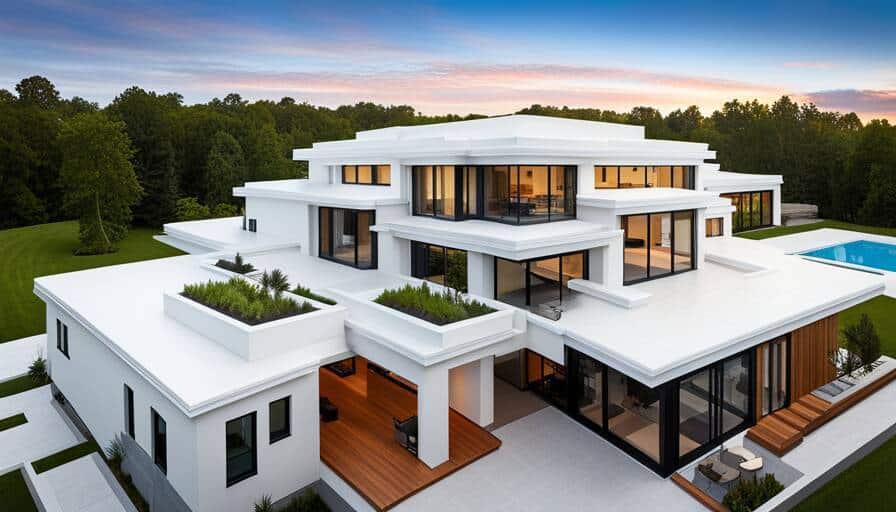Understanding Spray Foam Roofing
Spray foam roofing is a unique and innovative solution for both commercial and residential buildings. It involves the application of a liquid foam material that expands into a solid, durable, and seamless roofing system. During the installation process, two chemical components are combined and sprayed onto the roof, creating a protective layer that adheres to various surfaces. This insulation material provides exceptional thermal resistance, waterproofing properties, and structural integrity.
- The National Association of Home Builders reported that the typical cost of spray foam roofing ranges from $1.50 to $3.00 per square foot, depending on the thickness and type of foam used.
- A study conducted by the Spray Polyurethane Foam Alliance (SPFA) found that energy savings from spray foam roofing can recoup the initial installation cost within five to six years after installation.
- According to a report by Buildings.com, the lifespan of a properly maintained spray foam roof can exceed 30 years, potentially offsetting the initially higher installation cost compared to other roofing materials.
The Benefits of Spray Foam Roofing
Spray foam roofing offers numerous benefits that make it an attractive option for property owners. First and foremost, its excellent insulation capabilities provide significant energy savings by minimizing heat transfer between the interior and exterior of the building. This can lead to reduced heating and cooling costs throughout the year. Additionally, spray foam roofing acts as a seamless barrier against water infiltration, preventing leaks and potential damage to the underlying structure.
Spray foam is also known for its durability and longevity. Unlike traditional roofing materials with multiple seams and joints that can deteriorate over time, spray foam forms a continuous protective layer without those weak points. It can withstand extreme weather conditions, including high winds and hail, ensuring long-term performance.
Another advantage of spray foam roofing is its versatility. It can be applied to almost any type of roof surface, including flat roofs or those with irregular shapes. This adaptability makes it suitable for various architectural designs.
Furthermore, spray foam roofing requires minimal maintenance compared to other roofing options. Regular inspections and minor repairs are usually sufficient to ensure its continued effectiveness.
For example, consider a business owner who decides to invest in spray foam roofing for their commercial property. They were initially attracted by its insulation qualities but were pleasantly surprised by other benefits as well: lower energy bills due to improved energy efficiency, fewer interruptions caused by leaks or repairs, and peace of mind knowing their investment would last for many years to come.
Spray Foam Roofing Cost Analysis
When considering roof replacement or installation options, understanding the cost is a critical factor for many homeowners. Spray foam roofing has gained popularity due to its energy-efficiency and long-lasting benefits. However, it’s important to conduct a thorough cost analysis to determine if spray foam roofing aligns with your budget. Factors such as materials, labor, and additional expenses need to be taken into account.
Spray foam roofing costs can vary depending on several factors, including the size of the roof, accessibility, and regional pricing variations. It’s advisable to consult with professional roofing contractors who specialize in spray foam roofing to get accurate estimates for your specific project.
Breaking Down Labor and Materials Costs
When analyzing the cost of spray foam roofing, it’s essential to understand the breakdown between labor and materials. The labor cost includes the expertise and time required for proper installation. Spray foam roofing application involves trained professionals using specialized equipment to apply the foam evenly and effectively.
The materials cost consists of the spray foam itself, which typically comes in two components that are mixed together during application. Additional materials may include primer, coatings, sealants, and other accessories necessary for proper installation.
It’s worth noting that while spray foam roofing may have higher upfront costs compared to some traditional roofing options, it offers long-term energy savings and potential reductions in heating and cooling expenses over time.
Now that we’ve analyzed the general aspects of spray foam roofing costs, let’s move on to comparing it with alternative roofing options.
Comparing Spray Foam Roofing with Alternatives
When it comes to selecting the right roofing option for your property, it’s important to consider various factors such as durability, energy efficiency, and cost. One promising option to explore is spray foam roofing. Unlike traditional roofing materials like asphalt or metal, spray foam roofing offers unique advantages that are worth considering.
Spray foam roofing provides a seamless and durable layer of insulation that can help reduce energy costs by preventing air leakage and improving thermal performance. It also acts as a protective barrier against moisture infiltration, which can lead to costly damages if left unaddressed. Additionally, spray foam roofing is lightweight and can conform to any shape or size, making it suitable for a wide range of structures.
Cost Differences and Reasons
While the initial cost of installing spray foam roofing may be higher compared to some traditional roofing materials, it’s essential to consider the long-term benefits and cost savings associated with this option. Spray foam roofing offers exceptional energy efficiency, which can result in significant reductions in heating and cooling costs over time.
Moreover, due to its seamless application process, potential future repairs or maintenance needs are minimal compared to other roof types. This reduces both time and expenses associated with ongoing roof maintenance.
Spray foam roofing also has an extended lifespan when properly maintained. With routine inspections and periodic re-coatings, it can last for several decades without the need for replacement. This longevity helps offset the initial investment while providing added peace of mind.
It’s important to note that each roofing material has its own set of advantages and considerations. Factors such as climate, building structure, local regulations, and personal preferences should be taken into account when making a decision. Consulting with professional roofers who specialize in spray foam roofing can provide valuable insights and help determine the most cost-effective choice for your specific circumstances.
Case Studies in Roofing Costs
To truly understand the cost comparisons between spray foam roofing and other roofing options, let’s explore some case studies that highlight real-life scenarios. These studies will provide practical insights into the costs involved and the benefits of spray foam roofing.
In one case study, a homeowner in a hot and arid climate was considering a roof replacement for their single- family home. The existing asphalt shingle roof was showing signs of wear and required frequent repairs due to sun damage and leaks. After consulting with roofing contractors, the homeowner received quotes for both traditional asphalt shingle roofing and spray foam roofing.
The initial cost estimate for the asphalt shingle roof came in at $10,000, which included materials and labor. However, the homeowner was also advised to consider additional costs such as regular maintenance, potential repairs, and increased cooling expenses due to poor insulation.
On the other hand, the quote for spray foam roofing totaled $15,000 upfront. While this may seem higher initially, it included not only material and labor costs but also enhanced insulation properties that would lead to energy savings over time.
Another case study involves a commercial building owner who needed to address recurring leaks in their flat roof. They compared the costs of replacing the existing flat roof with various options, including built-up roofing (BUR) and spray foam roofing.
The BUR option had an estimated cost of $20 per square foot including materials and labor. However, it required periodic maintenance and needed replacement after approximately 15-20 years. This additional maintenance and the cost of future replacements added significantly to its lifecycle cost.
In contrast, spray foam roofing was estimated at $25 per square foot. While slightly more expensive upfront, it offered superior insulating properties and increased durability that could extend its lifespan up to 40 years or more with minimal maintenance requirements.
Real-life Comparisons and Conclusions
Based on these case studies and real-life comparisons, it becomes evident that spray foam roofing may initially have a higher upfront cost compared to other roofing options. However, it offers long-term benefits that can contribute to overall cost savings.
Spray foam roofing’s superior insulation properties help reduce energy consumption, leading to lower cooling and heating costs over time. Its durability and minimal maintenance requirements ensure fewer repairs and replacements in the future, saving homeowners and commercial building owners both time and money.
Moreover, considering the environmental impact, spray foam roofing is known for its energy-efficiency and reduced material waste during installation. This makes it an attractive option for those seeking sustainable roofing solutions.


